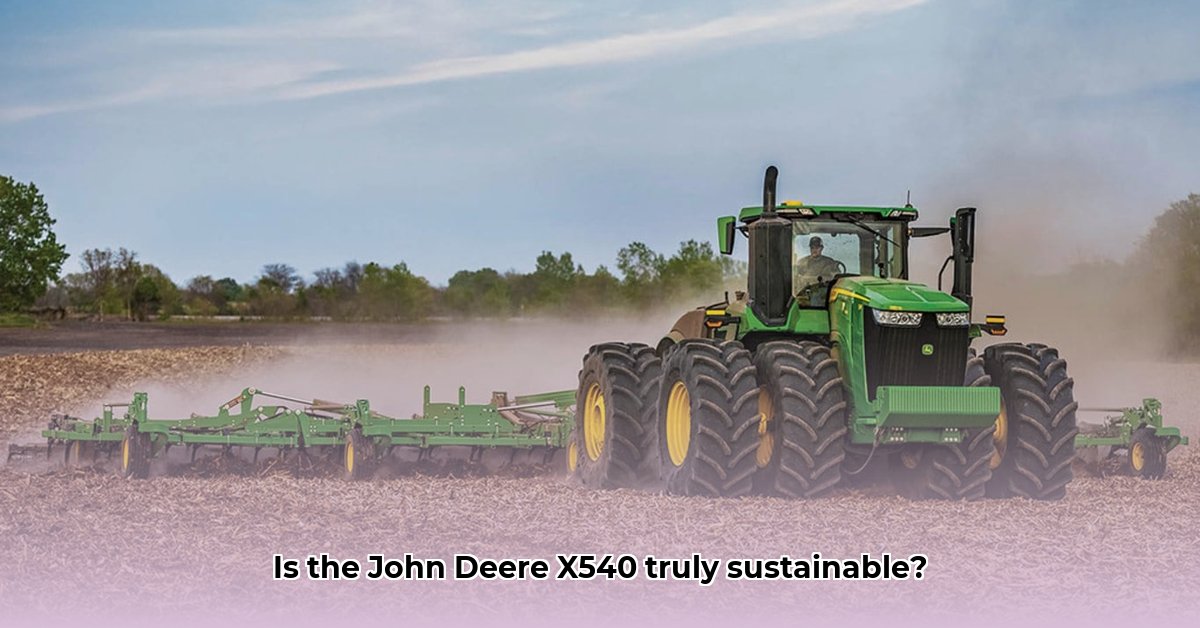
The John Deere X540 garden tractor, manufactured from 2006 to 2014, presents a complex case study in sustainable agriculture. Its longevity and robust build offer potential environmental benefits, but its gasoline engine and lack of advanced features pose significant challenges. This analysis explores the X540's sustainability profile, considering its lifecycle impacts and offering actionable insights for various stakeholders. For more information on John Deere equipment, check out this helpful resource.
A Lifecycle Assessment of Sustainability
Assessing the X540's sustainability requires a holistic lifecycle perspective, encompassing manufacturing, operation, and disposal. While comprehensive lifecycle assessment (LCA) data specific to the X540 is unavailable, analyzing its strengths and weaknesses provides a valuable insight.
Durability and Reduced Equipment Turnover: A Positive Aspect
The X540's robust construction contributes to a longer lifespan than many modern tractors. This extended longevity reduces the need for frequent replacements, minimizing the environmental impact associated with manufacturing and disposing of new equipment. "The durability of the X540 is frequently cited by owners," explains Dr. Anya Sharma, Professor of Agricultural Engineering at Purdue University. "This translates to a significant reduction in the embodied carbon associated with equipment replacement." The availability of replacement parts further enhances this positive aspect, extending the operational lifetime of the machine and reducing waste.
High Fuel Consumption and Emissions: A Major Drawback
The X540's gasoline engine significantly undermines its sustainability credentials. Fuel efficiency is considerably lower compared to diesel engines or newer, more technologically advanced models. Consequently, greenhouse gas emissions are significantly higher. This high fuel consumption directly counteracts the positive environmental aspects of extended lifespan. "The fuel economy of the X540 is a considerable drawback," states Dr. Ben Carter, Agricultural Economist at the University of California, Davis. "This high fuel consumption directly translates into a larger carbon footprint during the operational phase of the tractor's life." Furthermore, the absence of precision farming technologies limits opportunities for optimizing resource use (fertilizers, pesticides, water), which further negatively impacts the overall sustainability score.
Technological Limitations: Precision and Efficiency
The absence of advanced features like GPS-guided systems hinders the X540's potential for precision agriculture. Modern tractors with such capabilities allow for optimized fertilizer and pesticide application, resulting in reduced environmental impact and improved resource efficiency. The X540's technological limitations therefore represent a significant sustainability shortcoming in comparison to more recent models.
Actionable Steps for Sustainable Improvement
To mitigate the environmental impact associated with the X540, several stakeholders can take targeted measures:
1. Optimizing Operational Practices: For Farmers
- Reduce idle time: Minimize unnecessary idling to conserve fuel and reduce emissions.
- Proper maintenance: Regular maintenance ensures optimal engine performance and extends the machine's lifespan.
- Efficient operation: Carefully plan work routes and use appropriate attachments to optimize efficiency.
2. Extended Lifespan through Repair and Maintenance: For Dealers and Mechanics
- Provide comprehensive maintenance services: Offer preventative maintenance, repair, and parts replacement to extend the X540's operational life.
- Promote sustainable repair practices: Utilize recycled or remanufactured parts where possible.
- Proper disposal protocols: Offer responsible disposal and recycling options for end-of-life machines.
3. Research and Technological Development: For Researchers and Engineers
- Conduct comprehensive LCAs: Conduct detailed lifecycle assessments of similar agricultural machinery to build a better understanding of their overall environmental footprint.
- Develop more sustainable technologies: Focus research on developing and implementing affordable, sustainable farming technologies.
4. Policy Incentives for Transition: For Policy Makers
- Incentivize responsible equipment disposal: Implement programs that incentivize the responsible disposal and recycling of old farm equipment.
- Support the transition to sustainable technology: Provide financial incentives, tax breaks, or subsidies for adopting zero-emission or fuel-efficient alternatives.
Conclusion: A Balanced Perspective
The John Deere X540’s sustainability is a nuanced issue. The tractor's robust build promotes longevity, a significant positive factor. However, its high fuel consumption and lack of precision technologies negatively impact environmental performance. The absence of precise LCA data emphasizes the need for further research and a proactive approach toward sustainable agricultural practices. The ultimate assessment depends heavily on individual farming practices and the context of use, highlighting the need for a multi-faceted approach to sustainable agricultural equipment selection and management. Careful consideration of both short-term costs and long-term environmental impacts is imperative.